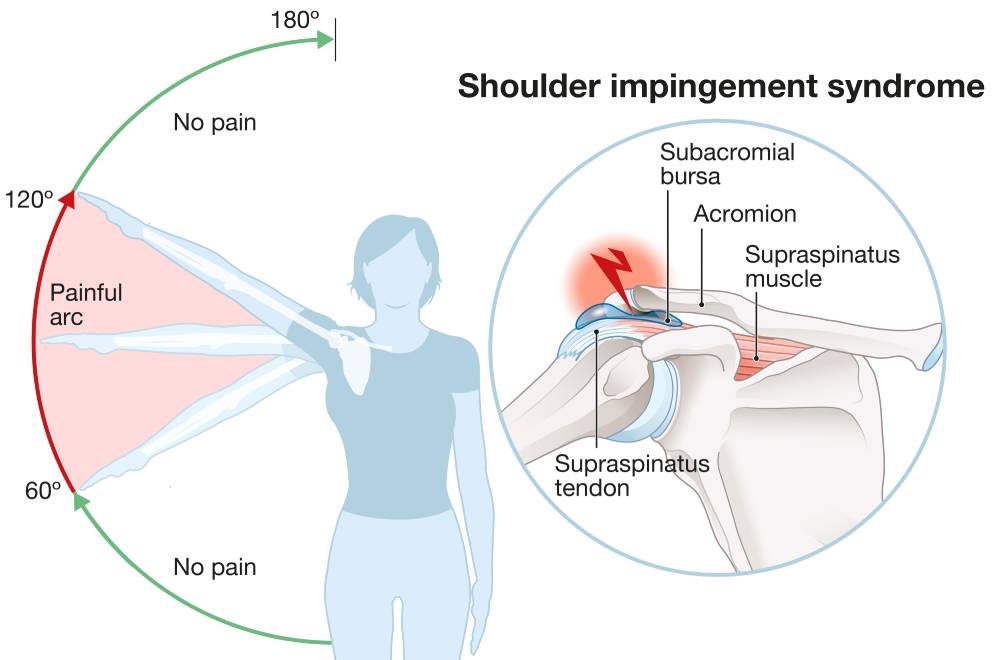Shoulder Impingement: Introduction
Shoulder impingement syndrome refers to a condition where the tendons or bursa (small fluid-filled sacs) of the rotator cuff muscles in the shoulder become compressed or pinched.
It is often caused by repetitive overhead motions or activities that put stress on the shoulder, such as throwing a ball or lifting weights.
Symptoms may include pain when reaching overhead or behind the back, weakness in the shoulder, and difficulty lifting objects
Activities that may put stress on the rotator cuff tendons and bursa also include swimming, weightlifting, or painting.
Over time, these repetitive motions can lead to inflammation and irritation of the tendons and bursae
Risk factors for Shoulder Impingement Syndrome
Other factors that can contribute to the development of shoulder impingement syndrome include poor posture, muscle imbalances, bone spurs and calcifications within the rotator cuff tendons e.g. Calcifications within the Supraspinatus tendon.
Poor posture can lead to an imbalance in the muscles of the shoulder and upper back, which can contribute to Shoulder Impingement.
Muscle imbalances, such as weak rotator cuff muscles or tight chest muscles, can also increase the risk of Shoulder Impingement.
Why does Shoulder Impingement Syndrome occur?
Anatomy

Lets take a look at the Anatomy
The rotator cuff is a group of four muscles (supraspinatus, infraspinatus, teres minor, and subscapularis) and their tendons that attach to the humerus (upper arm bone) and help to stabilize and move the shoulder joint.
The key structures involved in shoulder impingement are the rotator cuff tendons and the subacromial bursa.
Bone spurs or other anatomical abnormalities within the shoulder joint contribute to the development of impingement by narrowing the space through which the rotator cuff tendons and bursa must pass.
This space is essentially the space under the acromion (bony process at the tip of the shoulder blade)
The subacromial bursa sits between the rotator cuff tendons and the acromion (the bony process at the top of the shoulder blade).
In shoulder impingement, the rotator cuff tendons and/or subacromial bursa become ‘squeezed’ between the humeral head (the ball-shaped top of the upper arm bone) and the acromion upon shoulder movement.
This can cause irritation, inflammation, and ultimately, pain and limited mobility in the shoulder. Often this can lead to a bursal effusion.
Does Shoulder Impingement cause pain?
Shoulder impingement can result in pain in the shoulder.
The pain may be felt at the top or front of the shoulder, and it may also radiate down the arm. The pain may be worsened by overhead activities, reaching behind the back, or lifting heavy objects.
In addition to pain, impingement can also cause weakness and limited mobility in the shoulder.
If left untreated, shoulder impingement can lead to further damage to the rotator cuff tendons and can even result in a rotator cuff tear, which can require surgery to repair.
Can Shoulder Impingement restrict Shoulder movement?
Shoulder impingement can make it difficult to move the shoulder joint freely.
Over time, the inflammation and pain can lead to muscle weakness and stiffness, which can further limit range of motion.
The specific type of range of motion limitation can depend on the severity and location of the impingement.
For example, impingement of the supraspinatus tendon can result in difficulty lifting the arm above the shoulder, while impingement of the subscapularis tendon can make it difficult to rotate the arm sideways (or reach across the body).
Sometimes the impingement may be occurring at the Acromio-Clavicular Joint (AC joint) which can cause pain when lifting the arm beyond 90 degrees sideways or across the body.
These muscles may atrophy over time. This can result in difficulty lifting objects, weakness during overhead activities, and even difficulty with simple daily activities like combing your hair or reaching behind your back.
In addition, if the impingement is severe or if it is left untreated, it can lead to a rotator cuff tear, which can cause even more significant weakness and limited mobility in the arm.
Tests for Shoulder Impingement Syndrome
A physical exam for testing Shoulder impingement Syndrome typically consists of several components, including:
-
- Medical history: The clinician will take a thorough history regarding your symptoms
-
- Range of motion testing: The therapist will test the range of motion in your shoulder by asking you to move your arm in different directions and observing any limitations or pain.
-
- Strength testing: The therapist will test the strength of the muscles in your shoulder by asking you to perform certain movements against resistance, such as pushing or pulling against their hands.
-
- Palpation: The therapist will examine your shoulder by pressing on different areas to check for tenderness or swelling.
-
- Special tests: The Clinician may perform specific tests to evaluate for impingement, such as the Neer test, Hawkins-Kennedy test, or Jobe’s test.
Based on the results of the physical exam, the Clinician may order an X-rays or an MRI.
There are several imaging tests that can be used to help diagnose Shoulder Impingement Syndrome, including:
-
- X-rays: These can be used to evaluate the bones of the shoulder joint, including the humerus, scapula, and clavicle. X-rays can show bone spurs, calcifications, arthritis, or other bony abnormalities that may contribute to impingement.
-
- Ultrasound: Ultrasound can show signs of inflammation or damage to the shoulder structures and can be performed in real time to evaluate the shoulder during movement.
-
- MRI: This can show signs of inflammation, damage, or tears in the shoulder structures, and can provide information about the severity of the impingement.
Treatment for Shoulder Impingement Syndrome
Treatment involves rest, physical therapy, and exercises to improve range of motion and strengthen the muscles of the shoulder.
In some cases, cortisone injections or surgery may be necessary to relieve symptoms and restore range of motion.
Conservative treatment options for Shoulder Impingement Syndrome include:
-
- Rest and activity modification: Avoiding activities that exacerbate symptoms and resting the affected shoulder can help reduce pain and inflammation.
-
- Physical therapy: A physical therapist can teach you exercises to improve strength and flexibility in the muscles of your shoulder, which can help alleviate impingement and prevent future injury.
-
- Non-steroidal anti-inflammatory drugs (NSAIDs): Medications like ibuprofen or naproxen can help reduce pain and inflammation in the shoulder.
-
- Cortisone injections: Injections of Cortisone into the shoulder joint can help reduce inflammation and pain.
-
- Ice and heat therapy: Applying ice or heat to the affected shoulder can help reduce pain and inflammation.
-
- Activity modification: Avoiding overhead activities or modifying the way you perform certain activities, such as lifting or carrying heavy objects, can help reduce stress on the shoulder joint.
These conservative treatment options can be effective for many people with Shoulder Impingement Syndrome.
However, it is important to work with a therapist to develop an individualized treatment plan that addresses your specific symptoms and needs.
If conservative treatment is not effective, surgery may be necessary to relieve impingement and restore normal shoulder function.
How long does it take for Shoulder Impingement Syndrome to heal?
In general, conservative treatment options for shoulder impingement may take several weeks to several months to achieve full recovery.
For mild cases, rest, activity modification, physical therapy, and other conservative treatments may be effective within a few weeks to a few months. For more severe cases, recovery may take several months or longer, especially if surgery is required.
It is important to follow the treatment plan prescribed by your therapist and to communicate any changes in your symptoms or progress.
With proper treatment and rehabilitation, most people with shoulder impingement can achieve significant pain relief and return to their normal activities over time.
However, some people may experience lingering symptoms or require ongoing maintenance therapy to manage their condition.
Strengthening Exercises for Shoulder Impingement Syndrome

It is important to consult with a physical therapist before beginning any exercise program for Shoulder Impingement Syndrome, as some exercises may aggravate the condition.
However, in general, rehab exercises focus on improving the range of motion, strength, and flexibility in the muscles and tendons surrounding the shoulder joint.
Here are some examples of exercises that may be helpful for individuals with Shoulder Impingement Syndrome:
-
- Scapular squeezes: Sit or stand with your arms at your sides and your shoulders relaxed. Squeeze your shoulder blades together, as if you are trying to hold a pencil between them. Hold for a few seconds, then release. This exercise can help improve scapular stability and strengthen the muscles around the shoulder blade.
-
- Pendulum swings: Stand with your unaffected arm resting on a table or chair for support. Allow your affected arm to hang down and gently swing it back and forth, side to side, and in circles. This exercise can help improve range of motion and loosen up the shoulder joint.
-
- External rotation with resistance band: Secure a resistance band to a stationary object at waist height. Hold the other end of the band with your affected arm, elbow bent and close to your side. Rotate your arm outward, away from your body, while keeping your elbow close to your side. Slowly return to the starting position. This exercise can help strengthen the rotator cuff muscles and improve shoulder stability.
It is important to work with a physical therapist to develop an individualized exercise program for shoulder impingement, as some exercises may be contraindicated or require modifications based on your specific condition and needs.
- There are several things you can do to help prevent Shoulder Impingement Syndrome:
-
- Practice good posture: Maintaining good posture can help prevent shoulder impingement by keeping the shoulder joint in a neutral position and reducing stress on the muscles and tendons.
-
- Strengthen shoulder muscles: Regular exercise and strength training can help build strong shoulder muscles, which can provide better support for the shoulder joint and reduce the risk of impingement.
-
- Avoid overuse and repetitive motions: Avoid repetitive motions or activities that put excessive strain on the shoulder joint, such as overhead lifting or throwing, without proper rest and recovery time.
Cortisone Injections for Shoulder Impingement Syndrome
Steroid injections, also known as Cortisone injections, may be used as a treatment option for shoulder impingement. The injection typically contains a combination of a Cortisone medication and a numbing agent, such as lidocaine, and is administered directly into the affected area of the shoulder.
The Cortisone injection helps reduce inflammation and pain in the shoulder joint. The numbing agent helps to provide immediate pain relief and may also allow for better movement and exercise therapy.
Cortisone injections are often recommended for individuals who have not responded well to conservative treatment options, such as rest, physical therapy, and anti-inflammatory medication.
Cortisone injections should be used under the guidance and supervision of a Clinician and should be combined with physical therapy for optimal results.
Shoulder Impingement Syndrome exercises to avoid
While exercise is an important part of treating Shoulder Impingement Syndrome, there are some exercises that may aggravate the condition and should be avoided. These include:
-
- Overhead press: This exercise involves lifting weights or resistance bands overhead, which can put excessive strain on the shoulder joint and aggravate impingement.
-
- Bench press: Similar to the overhead press, the bench press involves lifting weights or a barbell, which can place strain on the shoulder joint.
-
- Pull-ups: This exercise involves pulling the body up using the arms and shoulders, which can place strain on the rotator cuff muscles and exacerbate impingement.
-
- Lat pulldowns: Similar to pull-ups, this exercise involves pulling a weight down using the arms and shoulders, which can cause pain and discomfort in individuals with shoulder impingement.
-
- Internal and external rotations: These exercises involve rotating the arm inward or outward, which can place strain on the rotator cuff muscles and exacerbate impingement.
Shoulder Impingement Syndrome is a common condition caused by a various factors including certain repeated activities and faulty biomechanics of the shoulder. In most cases it responds well to conservative measures including physical rehab.
If you suspect you are suffering from Shoulder Impingement Syndrome, consult a clinician as soon as possible to prevent long-term damage to the shoulder joint or rotator cuff tendons or give us a call at MyMSK Clinic for quality care and treatment





